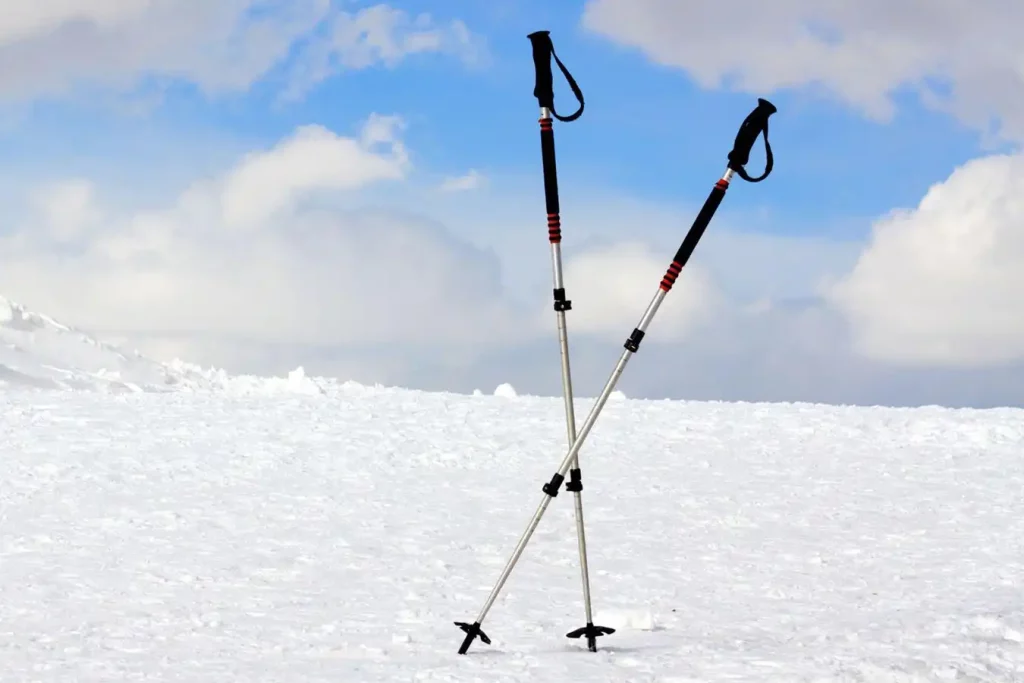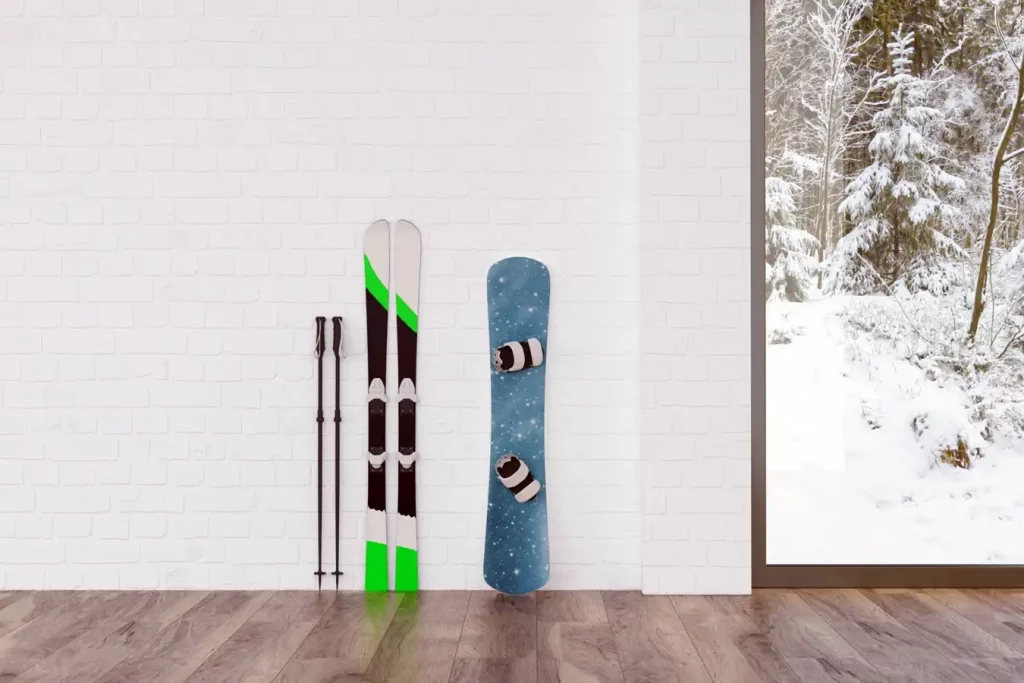“How long should ski poles be?” you might find yourself pondering as you prepare for your next snowy adventure.
It’s not just about aesthetics or fitting in with the crowd.
Picking the right length isn’t about looking cool; it’s about skiing better and safer.
Choosing incorrectly might set you back, both in terms of skill development and safety.
Dive in, and let’s get you sorted before your next slope session.
The Basics of Ski Poles
Before diving into the nitty-gritty of ski pole lengths, it’s crucial to understand why ski poles matter and the role they play in your snowy escapades.
Role and Importance of Ski Poles in Skiing
Ski poles are not just decorative add-ons to your ski gear; they play a fundamental role in maintaining balance and rhythm during both downhill and cross-country skiing. Think of them as your extra set of legs that provide additional support and control. They assist in timing your turns, pushing through flat sections, and keeping your body in the right skiing posture.
Remember that epic downhill run where I narrowly avoided a wipeout? The correct length of my ski poles was the unsung hero that day, helping me maintain my balance and steer away from disaster.

Different Types of Ski Poles and Their Uses
Ski poles come in all shapes and sizes, each designed for a specific type of skiing.
- Alpine Poles are your conventional ski poles, designed for downhill skiing. They have a straight shaft and a small, compact basket at the end to prevent them from sinking into the snow.
- Telescopic Poles are adjustable and versatile, allowing you to alter their length depending on your needs. They are ideal for backcountry or off-piste skiing where the terrain can change rapidly.
- Cross-Country Poles are significantly longer, designed to assist in propulsion on flat terrain. They often come with larger baskets for better support in softer snow.
Choosing the right type of ski pole is just the first step. Getting the length right is where the real game begins, a topic we’ll delve into in the next section. So, keep those bindings buckled, and stay tuned!
Factors Determining Ski Pole Length
Choosing the right ski pole length isn’t as straightforward as grabbing the first pair you see on the rack. Several key factors need to be taken into account to ensure you pick the perfect pair for your skiing adventures.
Skier’s Height
Unsurprisingly, your height plays a significant role in determining the ideal ski pole length. Generally, taller skiers need longer poles, while shorter ones require shorter poles. This correlation ensures that the poles are proportionate to the skier’s body, promoting better balance and control.
Skier’s Skill Level
The skill level of the skier also influences ski pole length. Beginners and intermediate skiers often fare better with shorter poles, which are easier to handle and provide greater control during turns. On the other hand, experienced skiers might opt for longer poles, providing more propulsion power and enhancing overall performance.
Skiing Style and Terrain
The type of skiing you indulge in and the terrain you’ll be conquering also impacts your ski pole length. For instance, downhill skiers and freestyle skiers generally prefer shorter poles for better control, while cross-country skiers need longer poles for efficient propulsion.
How to Measure Ski Pole Length
Now that we’ve considered the factors affecting ski pole length let’s delve into how you can measure the ideal length for your poles.
Standard Measurement Technique
A simple way to determine the right length for your ski poles is to turn the pole upside down, holding it just under the basket. Now bend your elbow at a 90-degree angle. If the pole is the correct length, the top of your hand should be touching the pole grip. This technique is commonly used and works well for the average recreational skier.
Remember that time I picked up a pair of ski poles that were way too long for me at a rental shop? I ended up with an unbalanced skiing posture and had quite a few hilarious (and embarrassing) falls!
Special Considerations for Different Skiing Styles
While the standard measurement technique works well in most scenarios, different skiing styles may require some tweaks to the pole length.
- Alpine Skiing: For downhill or alpine skiing, poles are typically shorter. When you hold the pole upside down with your hand under the basket and your elbow at a 90-degree angle, the end of the grip should be around your armpit.
- Cross-Country Skiing: Cross-country skiers use longer poles for efficient propulsion on flat terrain. The pole should reach up to your shoulder or even up to your chin in some cases.
- Freestyle Skiing: Freestylers or park skiers usually opt for shorter poles for better control during tricks. Some even prefer to ski without poles.
In my skiing adventures, I’ve found that having the right ski pole length dramatically enhances my skiing experience. So, take the time to get your measurements right – it’s worth the effort!
Understanding Ski Pole Sizing Charts
When it comes to ski pole sizing, many manufacturers and retailers provide sizing charts to assist you. These can be incredibly handy, but only if you understand how to read and interpret them correctly.
Reading and Interpreting Sizing Charts
A ski pole sizing chart typically lists a range of heights on one side and the corresponding pole lengths on the other. Keep in mind that these are guidelines, not hard-and-fast rules, and the exact length might vary depending on the factors we’ve previously discussed, like skiing style and skier’s skill level.
Take my friend Dave, for example. According to the sizing chart, his height of 6’3″ would typically need a pole length of 52 inches. But since he’s a downhill skier who likes to go fast and make tight turns, he opts for a slightly shorter pole at 50 inches for better control.
Common Mistakes When Using Sizing Charts
One common mistake is ignoring the considerations we discussed earlier – skier’s skill level and skiing style. Just like Dave, if you’re a downhill skier, you might want to go for a shorter pole than what the chart suggests. Conversely, if you’re into cross-country skiing, a longer pole might serve you better.
Also, don’t let the numbers on the sizing chart box you in. You’re not obliged to choose a pole length strictly according to the chart. Feel free to experiment a little to find out what works best for you!
Here’s a detailed table to give you a rough idea of how to match your height with an appropriate ski pole length:
| Skier’s Height (in feet) | Ski Pole Length (in inches) |
|---|---|
| Less than 4′ | 34 – 38 |
| 4′ – 4’4″ | 38 – 40 |
| 4’4″ – 4’8″ | 40 – 44 |
| 4’8″ – 5′ | 44 – 46 |
| 5′ – 5’4″ | 46 – 48 |
| 5’4″ – 5’8″ | 48 – 52 |
| 5’8″ – 6′ | 52 – 54 |
| More than 6′ | 54 – 58 |
Learn more: What Size Ski Poles Do I Need
Consequences of Incorrect Ski Pole Length
The consequences of choosing the wrong ski pole length can range from minor discomfort to severe impact on your skiing performance and safety.
Too Long Ski Poles: Potential Problems
If your ski poles are too long, you might find yourself leaning backward more than you should. This awkward stance can throw your balance off, making turning difficult and potentially leading to falls. Over time, it could also lead to back discomfort or even injury.
Remember that time I shared about my rental shop mishap? My overly long ski poles had me looking like a wobbly penguin on the slopes!
Too Short Ski Poles: Potential Issues
On the flip side, too short ski poles can make you hunch over, throwing your center of gravity forward. This posture can increase the strain on your knees and make downhill skiing especially challenging. In addition, you won’t be able to use your poles effectively for propulsion, especially in cross-country skiing.
So, as you see, getting the right ski pole length is crucial for a comfortable, efficient, and safe skiing experience.
Also learn: How to Attach Trekking Pole to Backpack
Adjusting Ski Pole Length: When and Why
A one-size-fits-all approach doesn’t work well with ski poles. As the conditions change or as you experiment with different skiing styles, you might need to adjust your ski pole length accordingly.
Adjusting for Different Skiing Conditions and Styles
Let’s revisit our buddy Dave for a second. When he’s zipping down groomed slopes, his trusty 50-inch poles serve him just fine. But when he’s off on backcountry adventures, he switches to longer poles for better support and balance in deep snow.
If you’re a skier who likes to switch between downhill, cross-country, and backcountry skiing, you might find adjustable ski poles to be a handy solution.
How to Adjust Adjustable Ski Poles
Adjustable ski poles typically come with a lock mechanism that allows you to change the length. Here’s a quick step-by-step guide on how to adjust them:
- Open the lock mechanism. This is usually a clamp or a twist-and-pull mechanism located somewhere along the shaft of the pole.
- Extend or retract the pole to your desired length.
- Lock the mechanism back in place. Make sure it’s secure before you start skiing!
Remember, always refer back to your personal comfort, the skiing style you’re opting for, and the terrain you’re tackling when adjusting your ski poles.
Read more: How Much Do Ski Boots Weigh
FAQs about Ski Poles Length
What is proper ski pole length?
How do you know if your ski poles are too long?
How long should a ski pole be cross country?
How do I choose ski length?
Conclusion
Choosing the right ski pole length is crucial for your comfort, efficiency, and safety on the slopes. Factors like your height, skill level, skiing style, and terrain all play a part in determining the ideal length.
We’ve walked through the basics of ski poles, factors determining the ideal length, how to measure it, understanding sizing charts, the consequences of incorrect length, and finally, adjusting your poles as needed.
I hope this guide serves you well in your quest for the perfect ski pole length. Remember, these are guidelines, and individual preferences may vary. Feel free to experiment a bit and find what works best for you. After all, skiing is about enjoyment and comfort.
Just as Dave adjusts his ski poles for different adventures, be flexible and open to adjustments as you navigate the thrilling slopes of your skiing journey.
Stay safe and enjoy the ride!
To know more: 11 Backpacks for Skiing


